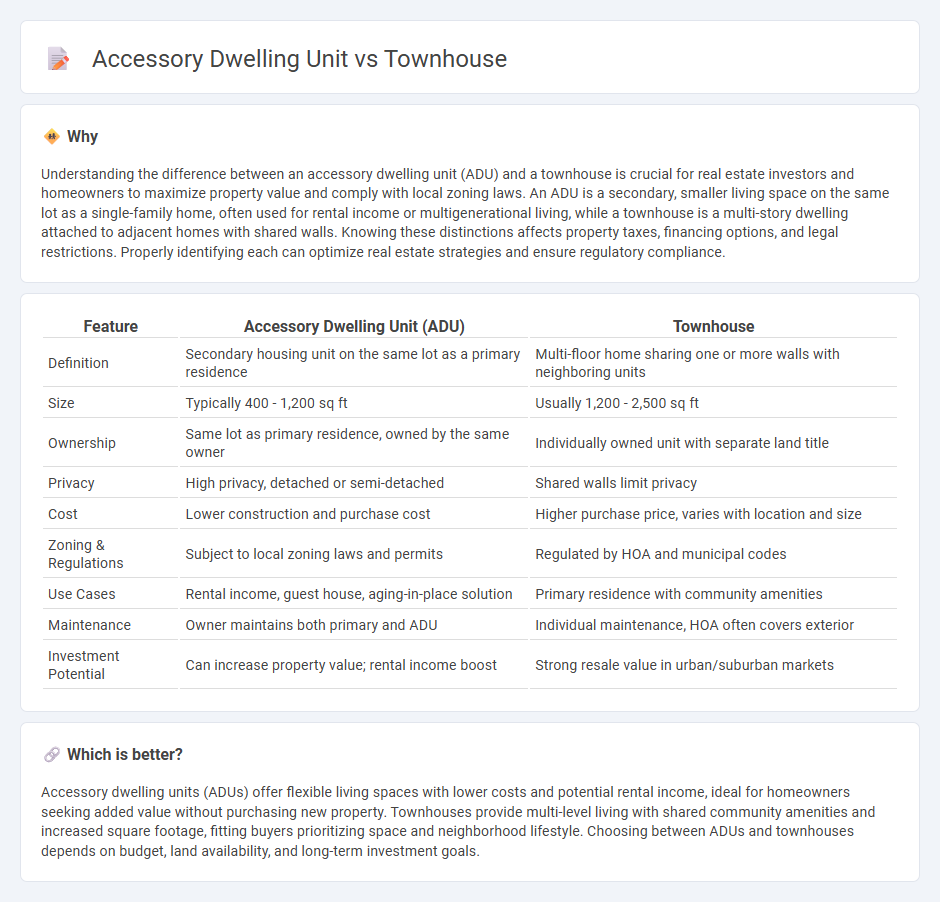
Accessory dwelling units (ADUs) offer flexible living space options that maximize property value and provide rental income opportunities without expanding building footprints. Townhouses, characterized by multi-level layouts and shared walls, deliver community living benefits with distinct private entrances and outdoor areas suitable for families. Explore the differences between ADUs and townhouses to determine the best real estate investment for your needs.
Why it is important
Understanding the difference between an accessory dwelling unit (ADU) and a townhouse is crucial for real estate investors and homeowners to maximize property value and comply with local zoning laws. An ADU is a secondary, smaller living space on the same lot as a single-family home, often used for rental income or multigenerational living, while a townhouse is a multi-story dwelling attached to adjacent homes with shared walls. Knowing these distinctions affects property taxes, financing options, and legal restrictions. Properly identifying each can optimize real estate strategies and ensure regulatory compliance.
Comparison Table
| Feature | Accessory Dwelling Unit (ADU) | Townhouse |
|---|---|---|
| Definition | Secondary housing unit on the same lot as a primary residence | Multi-floor home sharing one or more walls with neighboring units |
| Size | Typically 400 - 1,200 sq ft | Usually 1,200 - 2,500 sq ft |
| Ownership | Same lot as primary residence, owned by the same owner | Individually owned unit with separate land title |
| Privacy | High privacy, detached or semi-detached | Shared walls limit privacy |
| Cost | Lower construction and purchase cost | Higher purchase price, varies with location and size |
| Zoning & Regulations | Subject to local zoning laws and permits | Regulated by HOA and municipal codes |
| Use Cases | Rental income, guest house, aging-in-place solution | Primary residence with community amenities |
| Maintenance | Owner maintains both primary and ADU | Individual maintenance, HOA often covers exterior |
| Investment Potential | Can increase property value; rental income boost | Strong resale value in urban/suburban markets |
Which is better?
Accessory dwelling units (ADUs) offer flexible living spaces with lower costs and potential rental income, ideal for homeowners seeking added value without purchasing new property. Townhouses provide multi-level living with shared community amenities and increased square footage, fitting buyers prioritizing space and neighborhood lifestyle. Choosing between ADUs and townhouses depends on budget, land availability, and long-term investment goals.
Connection
Accessory dwelling units (ADUs) and townhouses are connected through their roles in increasing residential density within urban and suburban areas. Both housing types maximize land use efficiency by providing additional living spaces--ADUs as separate units on single-family lots and townhouses as attached multi-family structures. This connection supports affordable housing development and urban infill strategies by diversifying housing options without requiring large-scale new construction.
Key Terms
Ownership Structure
Townhouses are typically owned as individual properties with shared walls but separate ownership, allowing homeowners full control over their unit and an undivided interest in common areas. Accessory dwelling units (ADUs) are secondary housing units on a single-family property, usually under the same ownership as the primary residence, limiting separate ownership and transferability. Explore the legal and financial implications of each ownership structure to determine the best fit for your housing needs.
Zoning Regulations
Zoning regulations differentiate townhouses and accessory dwelling units (ADUs) by stipulating land use, density, and building specifications to control neighborhood development. Townhouses often require minimum lot sizes and adherence to setbacks, height limits, and parking provisions, while ADUs typically face restrictions on size, occupancy, and placement relative to the primary dwelling. Explore local zoning codes and ordinances to understand permitted uses and development standards for both housing types.
Shared Walls
Townhouses and accessory dwelling units (ADUs) differ significantly in their use of shared walls; townhouses typically share one or two walls with neighboring units, creating a continuous row of homes that optimize urban land use. In contrast, ADUs are often separate structures on the same property as a single-family home, with shared walls being less common but possible in attached ADUs. Explore more about how shared walls influence privacy, soundproofing, and building codes in multi-family versus accessory dwellings.
Source and External Links
Missing Middle Housing: Townhouse - This webpage describes a townhouse as a small-to-medium-sized attached structure with multiple dwelling units, typically facing a street or courtyard.
Townhouse Detroit - Townhouse Detroit is a venue in Detroit known for its atrium and outdoor terrace, ideal for hosting events and celebrations.
Wikipedia: Townhouse - A townhouse is a type of terraced housing with origins as a city residence for nobility, now found in various urban and suburban settings.
 dowidth.com
dowidth.com